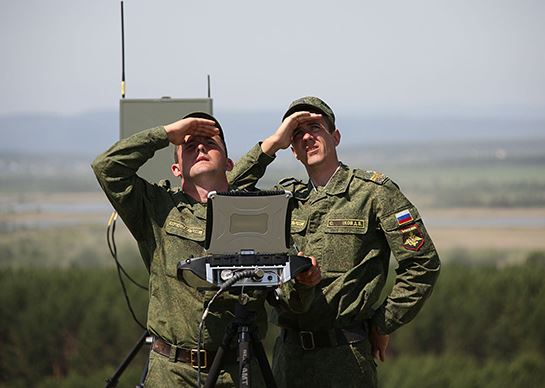
Russian Information Warfare—Not Just Hackers and Trolls
Publication: Eurasia Daily Monitor Volume: 13 Issue: 173
By:

“Information warfare,” according to the Russian definition of the term, combines technology (i.e., cyber warfare and electronic warfare) with psychology (“winning hearts and minds”) (Encyclopedia.mil.ru, accessed October 27). When commenting on the psychological aspect of Russian information operations, foreign observers generally focus on the strategic and operational level—for example messaging broadcast by the Russian propaganda channel Sputnik and online activities of so-called “trolls.” But what about the psychological aspect of Russian information warfare at the tactical level? This topic was recently discussed in an article by Colonel K. A. Trotsenko, “Information Warfare at the Operational-Tactical Command Level,” published in the August 2016 issue of Voennaya Mysl. The article should be seen in the context of a unique military exercise held in mid-August, in southwestern Russia (Mil.ru, August 19). The exercise, dubbed “Elektron 2016,” focused on electronic warfare and had an interesting feature: using spoofed cellular phone text messages to lure the “enemy” into an area specifically being pre-targeted by artillery and rocket fire.
Notably, information warfare was also, for the first time, a significant part of the large-scale follow-on exercise held in southwestern Russia during September 5–10—“Kavkaz 2016.” Therefore, it seems highly probable that the aforementioned article in Voennaya Mysl and Elektron 2016 were not an isolated phenomenon, but instead should be seen as being linked to the conduct of Russia’s subsequent Kavkaz exercise.
Exactly how information warfare was employed and put to use during Kavkaz 2016 is not known in detail. But upon its conclusion, news accounts noted the exercise was characterized by a high observance of information security best practices. For instance, according to the Russian chief of the General Staff, Army-General Valery Gerasimov, none of the Kavkaz participants were allowed to use cellphones at any point during the exercise (Rns.online, September 14). This suggests that the Russian military has taken to heart lessons from the conflict in Ukraine, whereby one side’s use of mobile phones can be exploited by the other to provide actionable intelligence.
During Kavkaz 2016, the Russian military organized a special group tasked with information warfare. This group consisted of representatives from the General Staff, personnel from the information warfare centers of the Russian military districts, members of various electronic warfare assets, as well as members of units from the service tasked with protecting state secrets (TASS, September 14). According to General Gerasimov, this information warfare group solved tasks similar to those normally undertaken by an indirect fire planning group, though the chief of staff did not elaborate further on the details. In some cases, he said, the information warfare group actually performed better at those tasks (Tvzvezda.ru, September 16). Colonel Trotsenko’s August article in Voennaya Mysl provides one blueprint for carrying out information warfare at the tactical level and, arguably, might reflect how information warfare was utilized during Kavkaz 2016.
For Russian forces operating at the tactical level, success will not come thanks to cyberattacks or Internet trolls, but rather by establishing information superiority and injecting oneself into the enemy’s decision cycle. In other words, the Russian military will attempt to force the adversary into making a new decision or modifying his previous decision in a manner detrimental to him. For Russian tacticians, this can be accomplished by using both technology and what can be characterized as “psychology.” These are two sides of the same coin, which must be employed in tandem: that is, the use of technology is a precondition for the use of psychology against the enemy.
In practice, the technical part aims to act on the adversary’s information processes—i.e., the collection and analysis of information and its subsequent dissemination in the form of tasks to the units—by targeting his systems for command and control. This is accomplished by electronic warfare, the preparation and use of kinetic energy against components in the adversary’s command and control system, but also by employing maskirovka (military deception) and reconnaissance. Psychology, or what the author calls “forestalling,” implies the use of a tactics by highly maneuverable forces, high-speed single maneuvers or the creation of special situations that the adversary’s command-and-control system cannot cope with. In addition, it requires denying the adversary the possibility to act in a similar manner against one’s own forces. In this context it is worth noting that “maneuver,” according to the Russian definition, refers not only to the maneuvering of military units, but also embodies maneuvering with fire and ordinance (Trotsenko, “Information Warfare at the Operational-Tactical Command Level,” Voennaya Mysl, August 2016).
What the article in Voennaya Mysl describes is, in essence, not new in the history of warfare. But in the Russian context, it may represent a new insight when it comes to Russian military tactics, ways to defeat the enemy, and how to act on the battlefield. One of the objectives of the military reforms initiated in 2008 was to create “a new officer,” although what that meant has never been clarified (Vpk.name, December 11, 2008). Some experts have interpreted this to mean an officer who is given more freedom of action and who is capable of showing initiative—a necessity on the modern battlefield (Oborona.ru, No. 7, July 2016). This understanding of the goal could very well be correct: indeed, from time to time, open-source reporting on Russian military exercises explicitly notes scenarios where personnel needed to think “outside the box.” So the stereotype of rigid Soviet and Russian tactics on the battlefield may be quickly becoming a thing of the past. And in a hypothetical future conflict with Russia, the appearance of “little green men” may not be the only surprise in store for allied militaries.



